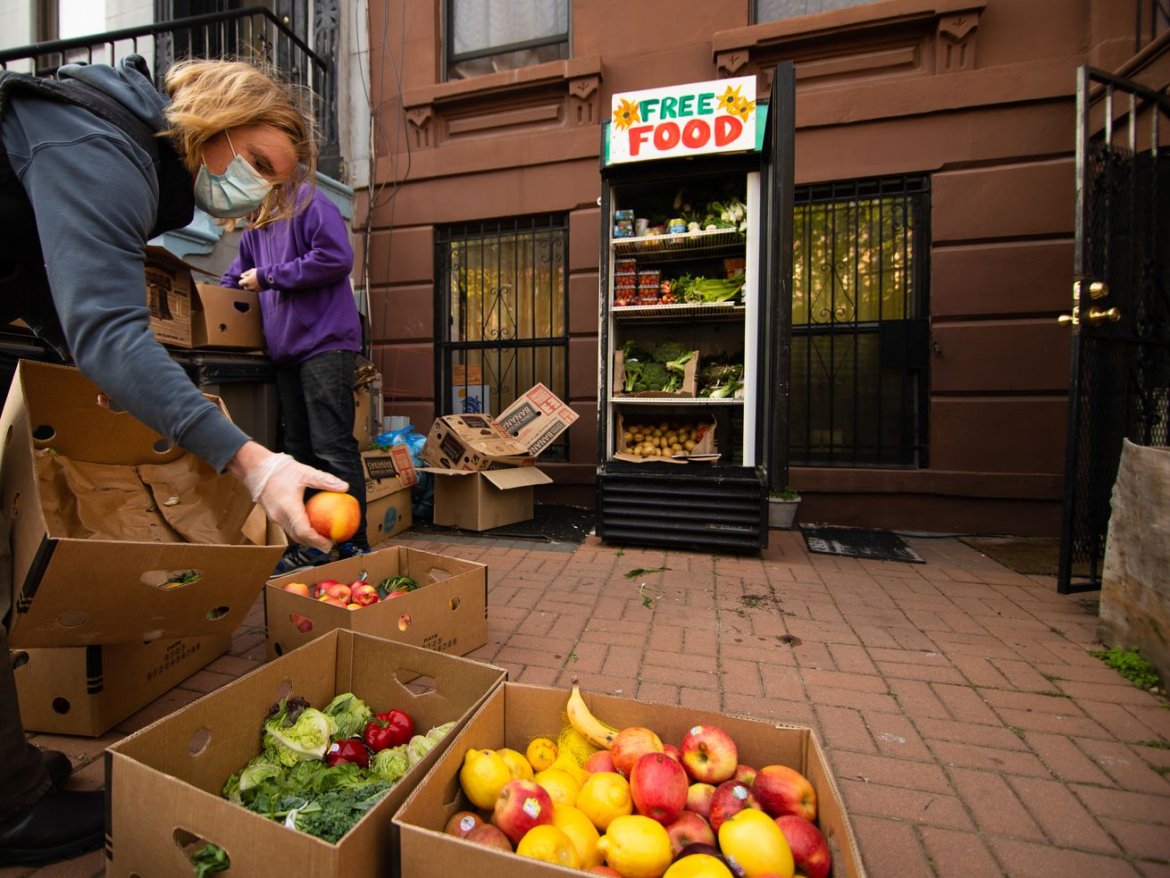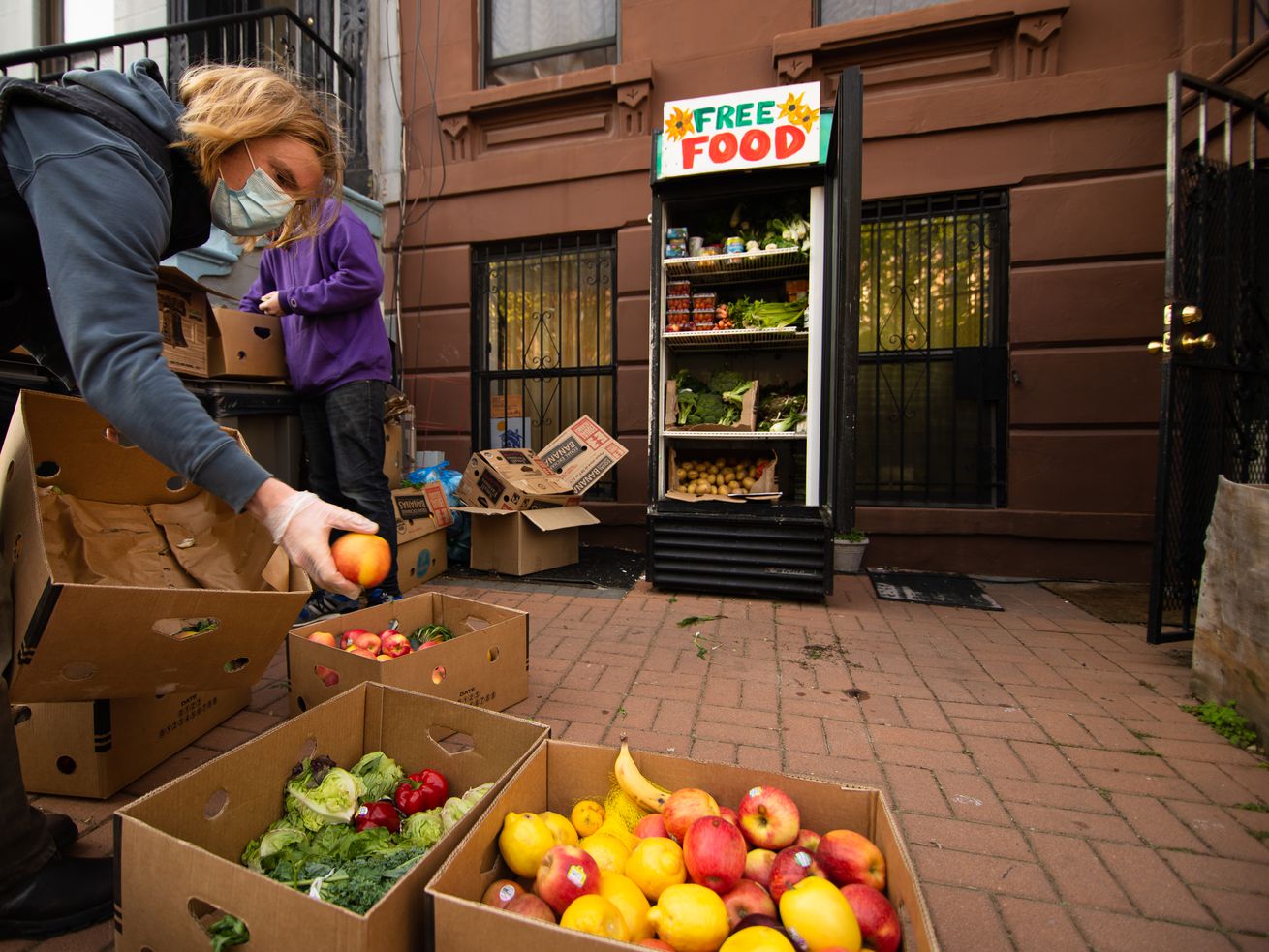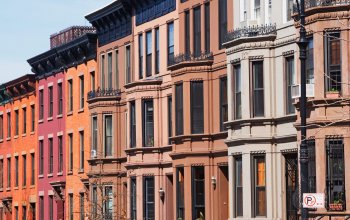
How community fridges are fixing a broken food system

 Located at 133 Van Buren Street, the Bed-Stuy community fridge offers free food anyone can access 24 hours a day. | Adela Wagner; adelawagner.com
Located at 133 Van Buren Street, the Bed-Stuy community fridge offers free food anyone can access 24 hours a day. | Adela Wagner; adelawagner.com
Across the city, community fridges are tackling hyperlocal food insecurity
In early February, Thadeaus Umpster found a free refrigerator on Craigslist. He intended to use the glass-door fridge, the kind you might find in a supermarket, to store donations for the weekly food share he helps run in Herbert Von King Park in Brooklyn. Just one problem: When he brought it home, it was too big to fit through the front door. He left it outside, within the small gated area in front of the Bed-Stuy brownstone he shares with roommates, while he figured out what to do with it. A few days later, one of the health-food stores that regularly donates to the food share arrived with a late delivery that included perishables. Umpster plugged in the fridge, filled it up, and drew “Free Food” and a heart on a piece of paper that he taped to the top of the fridge.
“The first night we set it out, I told my housemates, ‘I don’t know if this is a good idea. I don’t know if this is good for the house or if it might attract some negative energy,’” Umpster tells Curbed. “So far, we’ve only had positive interactions because of it.”
Food insecurity is a major issue in New York City, where an estimated 1.4 million people rely on emergency assistance like food pantries and soup kitchens—a sum that includes one out of every five children in the city—and 1.5 million people receive SNAP benefits. Countless more people go hungry than any single statistic can measure. Meanwhile, the COVID-19 pandemic has worsened the problem. Community fridges like Umpster’s are quickly becoming a neighborhood solution to food-security issues in the city and a way to forge tighter bonds within communities.
Between February and March, when the impacts of COVID-19 became severe, the fridge became even more needed as a resource.
The premise of the free-food fridge is simple: Take what you need and leave what you don’t. Umpster and his housemates keep the fridge clean and make sure it’s always stocked. On any given day, you might find fresh produce, eggs and dairy, bread, and grains inside; the mix depends on what’s been donated, but it’s what you’d typically find at a grocery store. In some instances, neighbors have taken raw items, cooked them, and returned prepared food.
MelPaola Murillo, an asylum seeker from Central America, is one of those neighbors. While she’s waiting on work permissions, she relies on free resources to survive. She lives about a mile away from the fridge and visits it weekly for things like plantains, tomatoes, nopales, cilantro, and parsley. Umpster posts images of the fridge’s contents on Instagram almost every day, so when it’s stocked with things Murillo likes, she comes by and takes what she needs.
“It feels good because no one is there asking questions or judging what or how much I take,” she says.
Recently, she picked up ingredients for plantain chips and bean soup and gave the cooked meal to Umpster. “I just want to show him the same solidarity he had shown me,” Murillo says.
The community fridge represents mutual aid—the idea that solidarity, not charity, is what communities need in order to become fairer and stronger—in one of its purest forms.
“We’re not rich people giving handouts,” Umpster says. “We eat this food too. This is where I get my dinner as well. We’re trying to do something good, and trying to help people out who may need it and might not want to go to a grocery store, too. When people are taking the time to get to know the people in their neighborhoods and communities, we’re stronger and more secure.”
Through word of mouth, media coverage of Umpster’s fridge, and heightened awareness of food insecurity due to the pandemic, the community-fridge idea has spread through the city thanks to individuals who wanted to contribute more to their neighborhoods. There are now nine fridges across the city: six refrigerators in Brooklyn, one in Manhattan, and two in the Bronx (one in Bushwick even has its own Instagram). Food is sourced and delivered to the refrigerators by a network of over 50 people that includes In Our Hearts, an anarchist organization, and Community Solidarity, a grassroots group that fights poverty, food insecurity, and food waste and also helps organize and source donations for the Bed-Stuy food share where Umpster volunteers.
Sade Boyewa, who has lived in Harlem for 25 years, saw an Instagram post of Umpster’s fridge. She immediately wanted one for her own neighborhood. She contacted him, and within a week she was able to get a fridge set up in front of a bodega on 116th Street and Manhattan Avenue, a block away from a community garden she established in 1995. In some ways, the community fridge is an extension of the work she originally did with the garden: It’s another way of supporting the people around her.
“People in my community don’t have what they need,” Boyewa says. “They don’t have the benefits, the food. There is already such a disparity. And there is such a surplus of food that goes to waste. Who could stand by and accept this?”
The fridge has been operating for a few weeks and, aside from one woman living in the building above the bodega who’s threatened to call the Department of Sanitation to remove it, the response has been overwhelmingly positive.
“It’s small grassroots organizations that are really taking care of people on the ground; it’s not the government,” Boyewa says. “With the community fridge, people are telling me, ‘Why didn’t this happen sooner?’ and ‘The fresh produce is so beautiful.’”
Every morning and evening, Boyewa checks on the fridge to sanitize it and to see if it’s working as intended. She’s never seen it empty, and she hasn’t seen any graffiti on it—proof, she says, that even a new concept like this one can be adopted successfully. For a while, she was nervous that it wouldn’t take.
“With something like a free-food fridge, it’s a completely new concept to a community,” Boyewa says. “When you see ‘free,’ you’re wondering, What does this mean? Is it good? Is it bad? Is it real? Is it safe? And there is also going to be a lot of guilt and shame involved in people actually accepting things that are free.”
Brianna Codner, a Harlem resident and audio engineer at the Borough of Manhattan Community College (BMCC), passed by the fridge around the time it was installed. She had never heard of the idea before but immediately fell for the notion of free, fresh food that anyone could grab whenever they needed.
“Since COVID-19, so many more people are unemployed and also aren’t able to do things like they normally do, like go to the market or stand in line,” Codner says. “And the lines out here in Harlem have been ridiculous.”
Codner has helped Boyewa hand out bags of food but hasn’t taken anything for herself yet. However, that might change soon. The budget cuts at BMCC have led to a furlough of her position, and money is getting tighter.
“The fridge is definitely something that would help me out,” she says. “Having a place that gives you groceries and free produce matters. Health matters completely at this time.”
Boyewa plans to keep the fridge going indefinitely and hopes it becomes a new normal elsewhere in the city.
“Everything to bring this to a larger scale is so needed,” Boyewa says. “There’s only so much we can do on a micro level in a ten-block, 20-block radius.”
Umpster hopes more community fridges are established throughout the city, too, and sees them as a triple threat: They address food insecurity, eliminate food waste, and create a fairer city.
“The reason we do this, besides not wanting to see food go to waste, is we believe it shouldn’t matter if you’ve lost your job, or if you don’t have a job, that you eat at night,” he says. “That’s something that sounds so basic, but it’s not something that people have consistently believed.”
Love where you live


